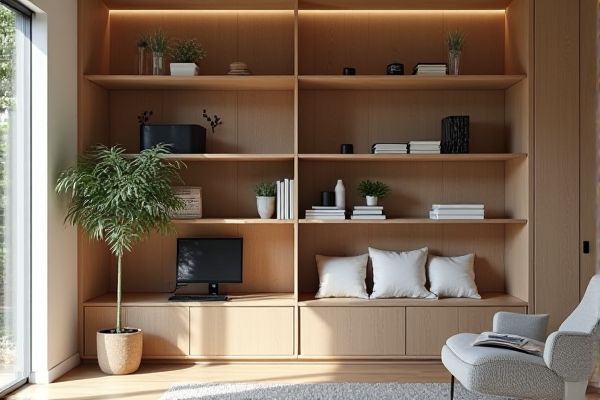
Concealed storage offers a clean, minimalist look by hiding items out of sight, enhancing room aesthetics and reducing visual clutter, while open storage provides easy access and display opportunities, promoting functionality and personalization. Discover which storage style best suits Your space and lifestyle by reading the rest of the article.
Table of Comparison
| Feature | Concealed Storage | Open Storage |
|---|---|---|
| Visibility | Hidden from view, items are stored out of sight | Items are fully visible and accessible |
| Security | Provides enhanced security and privacy | Less secure, items are exposed |
| Design Aesthetics | Clean, minimalist look, hides clutter | Decorative, showcases collections or frequently used items |
| Maintenance | Requires occasional cleaning inside storage units | Needs regular dusting and organization |
| Space Utilization | Optimizes space by using cabinets, drawers, and hidden compartments | Utilizes shelves and racks for open display |
| Accessibility | May require opening doors or drawers | Immediate access to items |
| Best For | Valuables, clutter reduction, private items | Decor, books, plants, frequently used objects |
Introduction to Concealed and Open Storage
Concealed storage refers to furniture or compartments designed to hide items from view, enhancing a clean and minimalist appearance in your living or working space. Open storage features shelves or racks that display belongings openly, promoting easy access and visual organization. Understanding the balance between concealed and open storage can help you optimize your space for both functionality and aesthetics.
Key Differences Between Concealed and Open Storage
Concealed storage hides items behind doors or panels, creating a clean, minimalist appearance and reducing visual clutter, which is ideal for small spaces or modern interiors. Open storage exposes items on shelves or racks, promoting easy access and display of decorative objects, enhancing room aesthetics and personalization. Key differences include visibility, accessibility, and design impact, with concealed storage prioritizing organization and discretion, while open storage emphasizes decoration and convenience.
Pros and Cons of Concealed Storage Solutions
Concealed storage solutions offer a sleek, clutter-free appearance that enhances room aesthetics and maximizes space efficiency by hiding belongings behind doors or panels. These storage options reduce visual distractions and help maintain a minimalist design, but they can limit quick access and require more complex installation compared to open storage. Additionally, concealed storage may lead to forgotten items due to reduced visibility, making organization and inventory management more challenging.
Advantages and Disadvantages of Open Storage
Open storage offers easy access and visibility, allowing you to quickly locate and retrieve items without the hassle of opening doors or drawers. It maximizes space efficiency and encourages organization by displaying belongings openly, but it can expose contents to dust, clutter, and potential damage, reducing overall protection. The lack of privacy may also affect aesthetics, requiring regular maintenance to ensure the area remains tidy and visually appealing.
Design Considerations for Storage Types
Concealed storage enhances room aesthetics by hiding clutter behind cabinet doors or panels, promoting a sleek and minimalist design ideal for modern interiors. Open storage offers easy accessibility and display opportunities for decorative items or frequently used objects, fostering an inviting and personalized space. Your choice between concealed and open storage depends on balancing visual appeal, functionality, and how you want to showcase or hide your belongings within the overall design scheme.
Security and Privacy: Concealed vs Open Storage
Concealed storage enhances security and privacy by restricting visibility and access to valuables, reducing the risk of theft and unauthorized handling. In contrast, open storage exposes items to plain sight, increasing vulnerability to pilferage and compromised confidentiality. Effective concealed storage solutions often incorporate locks, hidden compartments, or biometric access to safeguard sensitive belongings.
Aesthetic Impact of Storage Choices
Concealed storage creates a clean, minimalist aesthetic by hiding clutter and maintaining streamlined surfaces, making spaces appear more organized and spacious. Open storage emphasizes accessibility and display, showcasing items that contribute to your decor and personal style with visual interest. Your choice between concealed and open storage significantly affects the room's overall ambiance and perceived tidiness.
Maximizing Space Efficiency with Storage Options
Concealed storage maximizes space efficiency by hiding clutter and providing a streamlined look, making rooms feel larger and more organized. Open storage offers easy access and visibility, perfect for frequently used items, but can appear visually busy if not managed well. Your choice depends on balancing aesthetic preferences with practical needs to optimize storage effectiveness.
Best Use Cases for Concealed and Open Storage
Concealed storage is best suited for maintaining a clean, uncluttered appearance in spaces like bedrooms, offices, or living rooms where you want to hide personal items or clutter. Open storage excels in areas such as kitchens, libraries, or retail displays where easy access and visibility of items enhance functionality and aesthetic appeal. Your choice depends on whether you prioritize organization and privacy or accessibility and decorative display.
Choosing the Right Storage Solution for Your Needs
Concealed storage offers a clean, minimalist look by hiding items behind doors or panels, perfect for maintaining a clutter-free environment, while open storage provides easy access and display opportunities for frequently used or decorative items. Your choice depends on factors like room size, design style, and organizational preferences, with concealed storage excelling in discreet tidiness and open storage enhancing visual interest and accessibility. Assess your daily routines and space constraints to select the storage solution that optimally balances functionality and aesthetics.
 homyna.com
homyna.com